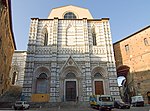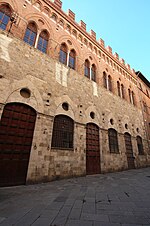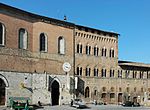Museo dell'Opera del Duomo (Siena)
1879 establishments in ItalyArt museums and galleries in SienaArt museums established in 1879Italian museum stubsReligious museums in Italy ... and 2 more
Use British English from December 2015Use list-defined references from December 2015

The Museo dell'Opera del Duomo is an art museum in Siena, in Tuscany in central Italy. It houses works of art and architectural fragments that were formerly in, or a part of, the Duomo of Siena (Siena Cathedral). These include a number of Italian Gothic sculptures by Giovanni Pisano and his school from the façade of the cathedral; the Maestà of Duccio di Boninsegna, which was the altarpiece from about 1311 until 1505: 519 or 1506;: 221 and works by Ambrogio and Pietro Lorenzetti. There are also works moved to the museum from other churches in the area, such as the Madonna of Duccio brought from the Pieve di Santa Cecilia at Crevole in the comune of Murlo.: 519
Excerpt from the Wikipedia article Museo dell'Opera del Duomo (Siena) (License: CC BY-SA 3.0, Authors, Images).Museo dell'Opera del Duomo (Siena)
Via di Monna Agnese, Siena San Prospero
Geographical coordinates (GPS) Address Nearby Places Show on map
Geographical coordinates (GPS)
| Latitude | Longitude |
|---|---|
| N 43.3177 ° | E 11.3296 ° |
Address
Museo dell'Opera del Duomo
Via di Monna Agnese
47065 Siena, San Prospero
Tuscany, Italy
Open on Google Maps










